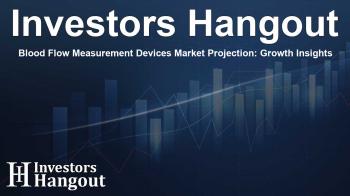Blood Flow Measurement Devices Market Projection: Growth Insights

Understanding the Blood Flow Measurement Devices Market
The blood flow measurement devices market is on a robust growth trajectory, with estimates suggesting it will exceed USD 1,652.1 million in the coming years. This surge is primarily driven by the rising demand for non-invasive diagnostics, particularly as the population ages and the prevalence of cardiovascular diseases escalates.
Market Growth Dynamics
Forecast Growth Rates
The global blood flow measurement devices sector is anticipated to increase from an estimated USD 886.0 million in 2025 to over USD 1.6 billion by 2032, reflecting a substantial compound annual growth rate (CAGR) of around 9.3%. This growth is underpinned by several key factors, including a significant increase in the elderly demographic and a growing preference for minimally invasive medical procedures.
Technological Enhancements Driving Demand
Recent advancements in technology, particularly in Doppler ultrasound systems, have significantly enhanced the accuracy and efficiency of blood flow detection. This leap in performance not only promises better patient outcomes but also encourages greater adoption of these sophisticated devices in clinical settings. However, manufacturers face challenges related to the high costs associated with advanced measurement technology, which can deter smaller healthcare facilities from embracing such innovations.
Impact of Chronic Illness on Market Dynamics
Increasing Prevalence of Cardiovascular Diseases
A crucial factor propelling the market for blood flow measurement devices is the increasing burden of chronic diseases, especially cardiovascular and peripheral vascular conditions. These devices facilitate timely monitoring and intervention, allowing for early detection of complications related to blood circulation, such as atherosclerosis and hypertension.
Rise of Non-Invasive Solutions
As healthcare evolves, there is a palpable shift towards favoring non-invasive diagnostic methods. This trend creates abundant growth opportunities for manufacturers of blood flow measurement devices who can respond to this demand by developing innovative solutions tailored to this market need. With an increasing elderly population, there is a higher requirement for devices that can provide critical blood flow assessments while minimizing patient discomfort.
The Role of AI in Enhancing Device Functionality
Artificial Intelligence Integration
The integration of Artificial Intelligence (AI) into blood flow measurement devices marks a pivotal trend in the industry. AI enhances diagnostic accuracy and allows for real-time monitoring. These advanced devices can alert clinicians to critical changes in patient conditions, ensuring timely medical responses. Moreover, AI-powered analytics can identify subtle variations in blood flow that might go unnoticed, further improving patient health outcomes.
Wearable Technology Innovations
With the IoT and cloud technology's evolution, wearable blood flow measurement devices are on the rise. These devices are becoming increasingly common in both clinical practices and home care settings. The shift towards portable and user-friendly designs promises to expand their use, making them accessible for patients who need consistent monitoring of their cardiovascular health.
Current Trends in the Market
Emerging Developments
The market for blood flow measurement devices is continuously evolving, with new innovations emerging. Companies are increasingly focusing on developing portable solutions that allow for easy and effective monitoring of blood flow, particularly during surgical procedures and recovery phases. These advancements not only enhance the safety and efficiency of surgical interventions but also boost patient outcomes.
Competitive Landscape
Several key players are actively transforming the blood flow measurement devices market. These include prominent companies that are recognized for their innovative technologies. Their commitment to research and development continues to fuel advancements in the diagnostic space, making it vital for competitors to stay ahead of emerging trends and market demands.
Frequently Asked Questions
What are blood flow measurement devices?
Blood flow measurement devices are medical instruments used to assess blood circulation in patients, crucial for diagnosing various cardiovascular conditions.
What is driving the growth of this market?
The market is driven by an aging population, an increase in cardiovascular diseases, and a growing preference for non-invasive diagnostic procedures.
How does AI impact blood flow measurement devices?
AI improves diagnostic accuracy, enables real-time monitoring, and enhances the functionality of devices through advanced analytics.
What are the main challenges faced by this market?
The high cost of advanced blood flow measurement devices poses a significant barrier to widespread adoption, particularly in smaller healthcare facilities.
Which companies are major players in this market?
Key companies in the blood flow measurement devices market include Medistim ASA, Cook Medical Inc., and Transonic Systems Inc., among others, leading the charge in innovation.
About The Author
Contact Ryan Hughes privately here. Or send an email with ATTN: Ryan Hughes as the subject to contact@investorshangout.com.
About Investors Hangout
Investors Hangout is a leading online stock forum for financial discussion and learning, offering a wide range of free tools and resources. It draws in traders of all levels, who exchange market knowledge, investigate trading tactics, and keep an eye on industry developments in real time. Featuring financial articles, stock message boards, quotes, charts, company profiles, and live news updates. Through cooperative learning and a wealth of informational resources, it helps users from novices creating their first portfolios to experts honing their techniques. Join Investors Hangout today: https://investorshangout.com/
The content of this article is based on factual, publicly available information and does not represent legal, financial, or investment advice. Investors Hangout does not offer financial advice, and the author is not a licensed financial advisor. Consult a qualified advisor before making any financial or investment decisions based on this article. This article should not be considered advice to purchase, sell, or hold any securities or other investments. If any of the material provided here is inaccurate, please contact us for corrections.

